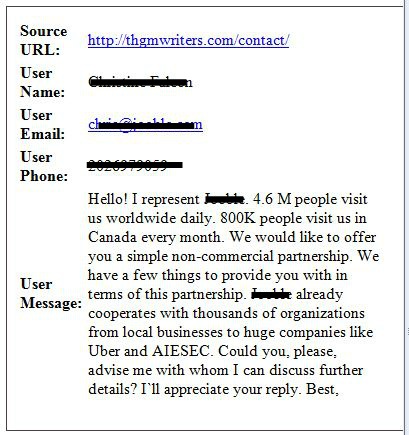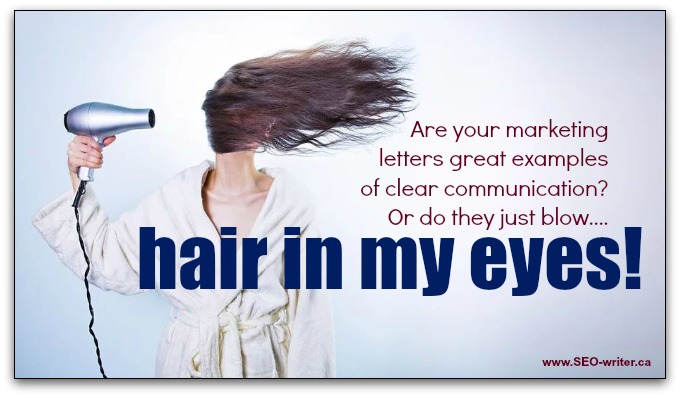Clear communication is critical in every aspect of life, especially to write a marketing letter that converts. So why would your marketing letter just blow hair in my eyes?
I recently received the email published in the image below. In fact, I received it three times. This is possibly the worst cold email I have ever received – and I have received thousands!
Instead of driving me to take action, the email just blew hair in my eyes.
From a company that is obviously so impressive, you would think they could do better. Let’s take a look at why this email sucks so badly.
Read the text version of the email.
Hello! I represent [COMPANY NAME]. 4.6 M people visit us worldwide daily. 800K people visit us in Canada every month. We would like to offer you a simple non-commercial partnership. We have a few things to provide you with in terms of this partnership. [COMPANY NAME] already cooperates with thousands of organizations from local businesses to huge companies like Uber and AIESEC. Could you, please, advise me with whom I can discuss further details? I`ll appreciate your reply. Best,
Time-tested formulas for the ideal marketing letter that converts
Let’s start with what we know. There are several formulas for the ideal marketing letter that converts prospects into customers. The most basic one is:
- Tell what you offer
- Tell how the client will benefit
- Call to action
A more advanced one is:
- Identify the pain
- Provide the solution
- Call to action
Of course, there’s the tried and true AIDA formula
- Attention – say something that makes them take notice
- Interest – get them thinking
- Desire – make them want what you’re selling
- Action – That’s the call to action
Each of these can be effective. The ideal one is the one that matches your audiences frame of mind when they see your message. That will depend on who your audience is, what you are selling and where the prospects are in the buying process.
This marketing letter’s formula
Before the call to action, you need to create desire. That is critical. I won’t act without a desire to do so.
This letter didn’t create desire. It created confusion – like blowing hair in my eyes.
When I read the email, here’s what went through my head:
- Huh…what?
- Oh, that’s two sentences.
- Wow, that’s impressive.
- What’s a non-commercial partnership?
- Wow, that’s impressive.
- Uh…so, what do you do?
- Delete.
In fairness, I did go back into my deleted folder to retrieve the email a few minutes later. But that was because I realized how superb an example it is of non-superb marketing for me to blog about.
That initial “Huh…what?” was because of a very simple grammar error that was violated. You know that rule about not starting a sentence with numbers? It turns out the rule is actually important. The first time I read this email, I missed the first period altogether, which I would not have done if the next sentence had started with a capital letter instead of a numeral.
So my first reaction was actually confusion. Hair in my eyes! That’s never a great way to start a marketing letter. But it’s an easy mistake to make…unless of course you test your letter with friends, family or colleagues.
So this letter left me confused in three ways: having to re-read the first two sentences, wondering what type of partnership it was proposing, and most of all not having a clue what the company does.
Based on this email, the company might do any of the following things:
- Make uniforms
- Gardening
- Deliver coffee
- Clean air ducts
- Accounting
It turns out that what it does isn’t even one of those five options. So much for my guessing super powers!
I don’t know anything about their features.
I don’t know why theirs might be better than their competitors.
I don’t have the slightest idea what they do, other than brag about how amazing they are ate whatever it is they do.
But they do make an offer:
We would like to offer you a simple non-commercial partnership. We have a few things to provide you with in terms of this partnership.
I have no idea what a “non-commercial partnership” partnership is, so I have no idea if it’s the kind of arrangement that might interest me. Apparently it offers “a few things”.
Maybe those few things are amazing. Maybe they are duller than a Marsh-wiggle‘s birthday party. But without a sense of what the offer is, at least in very broad terms, there is no incentive for me to invest the time in paying any further attention.
Delete.
If the letter had left out the word “non-commercial” I would not have wondered. I would not have been confused. If it hadn’t mentioned “a few things”, I would not have wondered. What if it had just said “We would like to discuss a partnership with you.”
The extra words were just more hair in my eyes.
Clear communications is critical in marketing
Even if the email had failed to be persuasive, it should have at least been clear. I should immediately know, with just a word or two, what the company does. If they are offering some sort of partnership, I should understand what they mean. Else, don’t even mention it.
When you write your marketing letters and copy, do you communicate clearly? Do you lead people through the copy to the inevitable conclusion that they should follow your call to action? If not, it’s time to scratch your draft and start over.
PS. Do you like hair in your eyes? Then you’ll love this Canadian country song “Hair in my eyes” by Corb Lund from Taber, Alberta.










